
The Salmon War (German : Lachsfangstreit) of 1736/37 was a political conflict between the confederate Canton of Basle and the Kingdom of France over fishing rights and the location of their state border in the River Rhine.

The Salmon War (German : Lachsfangstreit) of 1736/37 was a political conflict between the confederate Canton of Basle and the Kingdom of France over fishing rights and the location of their state border in the River Rhine.

In 1735 and 1736, at the start of the salmon season, there were again insults thrown and mass struggles between the fishermen of Neudorf, Hüningen and Kleinhüningen. On the Hüningen side about two dozen men were involved, on the Kleinhüningen side the figures vary between forty and two hundred. Basle fishermen also interfered on the grounds that the old regulations were no longer valid.
The conflict became a state-level issue through the news that the Obervogt of Kleinhüningen, Jakob Christoph Frey, an official of the Basle Estate, had been involved in the violence of 1736 and organized it out of his own interest. As part of his income, he received a third of the captured fish. In addition, the village guard had beaten his drum, giving the riot the character of a military engagement.
The accusations were denied by Basle, but French officials insisted their information was correct and exerted huge pressure on Basle by the end of the year. From 16 November onwards, they cut off Basle's trading links (in particular food supplies and income) with Alsace, banned Basle's citizens from travelling and arrested three of them in Strasbourg. They also demanded the prosecution of the Kleinhüningen parties and the Obervogt. Last but not least, they officially questioned the existing border markers.
A request for support from Basle to the Swiss states failed due to confessional and political antagonism and the influence of the French Ambassador in Solothurn. The extraordinary meeting demanded by Basle on early January 1737 did not make any decisions. Instead, it was suggested that Basle should back down. The French officials sharply rejected Basle's delegations in Strasbourg and Solothurn and its letters of justification to Paris. A number of arrests in Kleinhüningen and contacts with the Dutch ambassador in Paris did not contribute to a relaxation of tension. There were even rumours that France was planning a military intervention.
The Battle of Rastatt saw part of a Republican French army under Jean Victor Marie Moreau clash with elements of the Habsburg army under Maximilian Anton Karl, Count Baillet de Latour which were defending the line of the Murg River. Leading a wing of Moreau's army, Louis Desaix attacked the Austrians and drove them back to the Alb River in the War of the First Coalition action. Rastatt is a city in the state of Baden-Württemberg in Germany, located 89 kilometers (55 mi) south of Mannheim and 94 kilometres (58 mi) west of Stuttgart.

The canton of Basel-Stadt is one of the 26 cantons of Switzerland, and the smallest of the cantons by area. The city of Basel and the municipalities of Bettingen and Riehen form its territory.
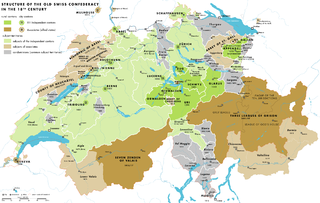
The early modern history of the Old Swiss Confederacy and its constituent Thirteen Cantons encompasses the time of the Thirty Years' War (1618–1648) until the French invasion of 1798.

Saint-Louis is a commune in the Haut-Rhin department in Alsace in north-eastern France.

Huningue is a commune in the Haut-Rhin department of Alsace in north-eastern France. Huningue is a northern suburb of the Swiss city of Basel. It also borders Germany. In 2008 it had a population of 6503 people. The main square of the town is the Place Abbatucci, named after the Corsican-born French general Jean Charles Abbatucci who unsuccessfully defended it in 1796 against the Austrians and died here. Huningue is noted for its pisciculture and is a major producer of fish eggs.
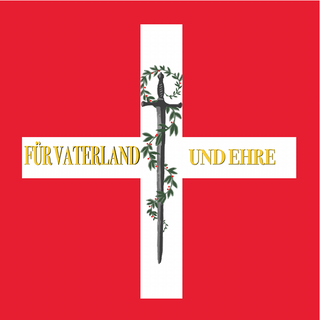
The periods of Restoration and Regeneration in Swiss history last from 1814 to 1847. "Restoration" refers to the period of 1814 to 1830, the restoration of the Ancien Régime (federalism), reverting the changes imposed by Napoleon Bonaparte on the centralist Helvetic Republic from 1798 and the partial reversion to the old system with the Act of Mediation of 1803. "Regeneration" refers to the period of 1830 to 1848, when in the wake of the July Revolution the "restored" Ancien Régime was countered by the liberal movement. In the Protestant cantons, the rural population enforced liberal cantonal constitutions, partly in armed marches on the cities. This resulted in a conservative backlash in the Catholic cantons in the 1830s, raising the conflict to the point of civil war by 1847.

The Old Swiss Confederacy was a loose confederation of independent small states within the Holy Roman Empire. It is the precursor of the modern state of Switzerland.
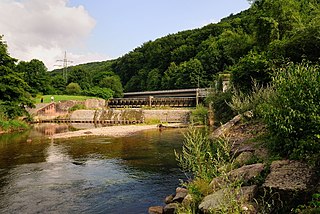
The Wiese is a river, 57.8 kilometres long, and a right-hand tributary of the Rhine in southwest Germany and northwest Switzerland.

BLT's tram line 10 is an international tramway line in Europe which is 25.6 kilometres (15.9 mi) in length. The line in the region of Basel, Switzerland, is operated by Baselland Transport (BLT).
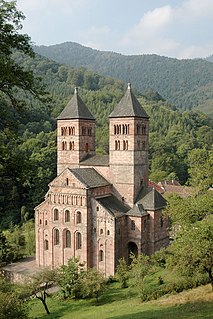
Murbach Abbey was a famous Benedictine monastery in Murbach, southern Alsace, in a valley at the foot of the Grand Ballon in the Vosges.

The Swiss Central Railway was one of the five major private railway companies of Switzerland. The SCB with a track length of 332 kilometres was integrated into the Swiss Federal Railways (SBB) in 1902.

The Basel tramway network is a network of tramways forming part of the public transport system in Basel, Switzerland, and the Swiss part of its agglomeration. It consists of 13 lines. Due to its longevity, it is part of Basel's heritage and, alongside the Basel Minster, is one of the symbols of the city.

Sozzini, Sozini, Socini or Socin is an Italian noble family originally from Siena in Tuscany, where the family were noted as bankers and merchants, jurists and humanist scholars. The family has been described as "the most famous legal dynasty of the Italian Renaissance."
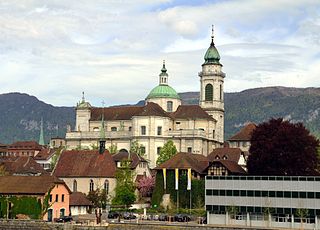
The St. Ursus Cathedral or Solothurn Cathedral is the cathedral of the Roman Catholic Diocese of Basel in the city of Solothurn, Switzerland. It is a Swiss heritage site of national significance.

During the Battle of Kehl, a Republican French force under the direction of Jean Charles Abbatucci mounted an amphibious crossing of the Rhine River against a defending force of soldiers from the Swabian Circle. In this action of the War of the First Coalition, the French drove the Swabians from their positions in Kehl and subsequently controlled the bridgehead on both sides of the Rhine.

In the Siege of Hüningen, the Austrians captured the city from the French. Hüningen is in the present-day Department of Haut-Rhin, France. Its fortress lay approximately 2.5 miles (4.0 km) north of the Swiss city of Basel and .5 miles (0.80 km) north of the spot where the present-day borders of Germany, France and Switzerland meet. During the time of this siege, the village was part of the Canton of Basel City and the fortress lay in area contested between the German states and the First French Republic.

The Second Battle of Kehl occurred on 18 September 1796, when General Franz Petrasch's Austrian and Imperial troops stormed the French-held bridgehead over the Rhine river. The village of Kehl, which is now in the German state of Baden-Württemberg, was then part of Baden-Durlach. Across the river, Strasbourg, an Alsatian city, was a French Revolutionary stronghold. This battle was part of the Rhine Campaign of 1796, in the French Revolutionary War of the First Coalition.

Abel Socin was a Swiss merchant, politician, law lord (Gerichtsherr) and diplomat from Basel. He was a member of the Grand Council of Basel and served as the envoy of the Swiss Confederation to the French court from 1679.

The Struve Putsch, also known as the Second Baden Uprising or Second Baden Rebellion, was a regional, South Baden element of the German Revolution of 1848/1849. It began with the proclamation of the German Republic on 21 September 1848 by Gustav Struve in Lörrach and ended with his arrest on 25 September 1848 in Wehr.

The Palais Besenval is a baroque palace at Kronengasse 1 in the Swiss city of Solothurn.